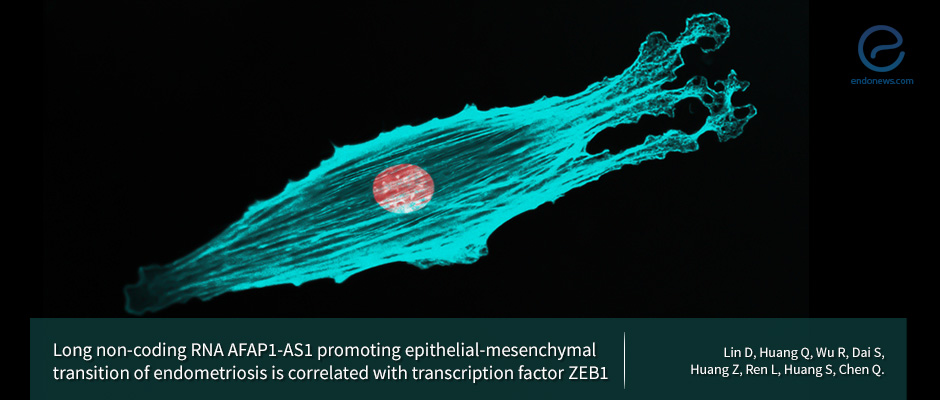Long non‐coding RNA, Epithelial mesenchymal transition, and Endometriosis
Mar 11, 2019
Long non‐coding RNA AFAP1‐AS1 promoting the epithelial-mesenchymal transition of endometriosis is correlated with transcription factor ZEB1
Key Points
Highlight:
- Dr. Chen group suggests that long non‐coding RNA AFAP1‐AS1 might induce endometriosis and EMT which is probably correlated with endometriosis pathogenesis.
Background:
- Epithelial‐mesenchymal transition (EMT) refers to the special biological process of epithelial cells transforming into a mesenchymal cell phenotype and has been receiving widespread attention for endometriosis.
- The loss of the epithelial phenotype provides good conditions for the development of endometriosis lesions.
- ZEB1 is an EMT‐related transcription factor that subsequently promotes the EMT process and the abnormal activation of endometriosis.
- Long non‐coding RNAs (lncRNAs) are a type of functional RNA molecules that are >200 nucleotides in length, highly dysregulated in ectopic endometrial tissues compared with those in paired eutopic endometrial tissues.
- Actin filament associated protein 1‐antisense RNA1 (AFAP1‐AS1) was one of these lncRNAs, which demonstrated a 47‐fold change.
- AFAP1‐AS1 has also recently been found to be correlated with malignant progression, and poor prognosis of numerous cancers. But, the role of AFAP1‐AS1 in endometriosis or its EMT process remains unclear.
- Here, Dr. Chen group from China investigated whether the EMT process occurred during the development of endometriosis, and the impact of AFAP1‐AS1 in this process.
Results:
- EMT phenomenon exists in endometriosis. In ectopic tissues, the expression level of epithelial-related markers (E‐cadherin, and keratin) are lower than the level in eutopic tissues.
- In contrast, the expression level of mesenchymal-related markers (vimentin and N‐cadherin) is much higher in ectopic tissues.
- AFAP1‐AS1 levels were much higher in ectopic endometrial tissues than that in eutopic tissues.
- The knockdown of AFAP1‐AS1 reduced the role of EMT by inhibiting cell proliferation, migration, and invasion.
- The transcriptional activity of ZEB1, a key factor for the EMT process, was highly suppressed by AFAP1‐AS1 knockdown.
- In the animal study, the size of subcutaneous tumors was significantly reduced after down‐regulation of AFAP1‐AS1 expression.
Conclusions:
- Higher expression of AFAP1‐AS1 positively correlated with greater EMT in ectopic endometrium of patients with endometriosis.
- By regulating ZEB1, long non‐coding RNA AFAP1‐AS1 might induce endometriosis and EMT which is probably correlated with endometriosis pathogenesis.
Lay Summary
Endometriosis is an estrogen‐dependent inflammatory gynecologic disease and requires attention. However, an in‐depth understanding of the latent pathogenesis of endometriosis development and its new innovative therapeutics are urgently needed.
Epithelial‐mesenchymal transition (EMT) refers to the special biological process of epithelial cells transforming into a mesenchymal cell phenotype and has been receiving widespread attention for endometriosis. The loss of the epithelial phenotype provides good conditions for the development of endometriosis lesions. ZEB1 is an EMT‐related transcription factor that subsequently promotes the EMT process and the abnormal activation of endometriosis.
Long non‐coding RNAs (lncRNAs) are a type of functional RNA molecules that are >200 nucleotides in length, highly dysregulated in ectopic endometrial tissues compared with those in paired eutopic endometrial tissues. Actin filament associated protein 1‐antisense RNA1 (AFAP1‐AS1) was one of these lncRNAs, which demonstrated a 47‐fold change. AFAP1‐AS1 has also recently been found to be correlated with malignant progression, metastasis, and poor prognosis of numerous cancers. But, the role of AFAP1‐AS1 in endometriosis remains unclear.
Here, Dr. Chen group from China investigated whether the EMT process occurred during the development of endometriosis, and the impact of AFAP1‐AS1 in this process.
First, they found that EMT phenomenon exists in endometriosis. In ectopic tissues, the expression level of epithelial-related markers (E‐cadherin, and keratin) are lower than the level in eutopic tissues. In contrast, the expression of mesenchymal-related markers (vimentin and N‐cadherin) is much higher in ectopic tissues. AFAP1‐AS1 levels were much higher in ectopic endometrial tissues than that in eutopic tissues.
The knockdown of AFAP1‐AS1 reduced the role of EMT. The AFAP1‐AS1 knockdown suppressed cell migration, invasion, and inflammation of ectopic endometrium epithelial cells. To determine the relationship between AFAP1‐AS1 and the EMT process, a luciferase assay was designed and used to monitor the activity of ZEB1 promoter. This group found that the transcriptional activity of ZEB1, a key factor for the EMT process, was highly suppressed by AFAP1‐AS1 knockdown. Finally, in the animal study, the size of subcutaneous tumors was significantly reduced after down‐regulation of AFAP1‐AS1 expression.
In conclusion, the higher expression of AFAP1‐AS1 positively correlated with greater EMT in ectopic endometrium of patients with endometriosis. Dr. Chen group suggests that by regulating ZEB1, AFAP1‐AS1 might induce endometriosis and EMT which is probably correlated with endometriosis pathogenesis.
Research Source: https://www.ncbi.nlm.nih.gov/pubmed/30506548
Endometriosis AFAP1‐AS1 EMT ZEB1

